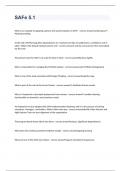,Chapter 1—Communication in a Global Workplace Environment
MULTIPLE CHOICE
1. Communication skills
a. are not as important as technical skills for career success.
b. are not necessary in today's competitive job market.
c. are ranked by recruiters at the top of qualities they most desire in job seekers.
d. cannot be learned; they are innate.
ANS: C
Studies confirm that recruiters rank communication skills at the top of qualities they most desire in job
seekers. Your ability to communicate will make you marketable and continue to be your ticket to
success regardless of the current economic climate. The good news is that effective communication
can be learned.
PTS: 1 DIF: Easy
OBJ: Bloom's Taxonomy: Comprehension
TOP: Communication in a Global Workplace Environment
2. Which of the following statements is most accurate?
a. Because today's workers are more geographically dispersed, the need for well-written
messages has declined.
b. Employers rank oral and written communication skills as less valuable than hard skills
such as mathematical computation, computer literacy, and troubleshooting.
c. Communication skills are critical to your job placement, performance, career
advancement, and organizational success.
d. Business letters and interoffice memoranda remain the top forms of business
correspondence.
ANS: C
Communication skills are critical to job placement, performance, and career advancement because the
need for well-written messages has increased, oral and written communication skills are the top skills
demanded by employers, and digital communication has replaced business letters and memos.
PTS: 1 DIF: Easy
OBJ: Bloom's Taxonomy: Knowledge
TOP: Communication in a Global Workplace Environment
3. On the job you are more likely to be taken seriously and promoted if you
a. look and sound professional.
b. frame your degree or certificate and hang it on your office or cubicle wall.
c. appear to be busy even when you're not really doing anything.
d. attend office parties.
ANS: A
If you look and sound professional while working, you are more likely to be taken seriously and to be
promoted.
PTS: 1 DIF: Easy
OBJ: Bloom's Taxonomy: Knowledge
Guffey, Du-Babcock, and Loewy | Essentials of Business Communication, 3rd Asia Edition
© 2016 Cengage Learning ● All Rights Reserved
1
, TOP: Non-verbal Communication | Verbal Communication
4. Which of the following statements is most accurate?
a. Workers today communicate less than in previous years.
b. Technology has not affected how and why we communicate.
c. Businesses today generate a wide range of messages in a variety of media.
d. Writing is a skill set used only by managers and corporate executives.
ANS: C
Because of technology, all workers will write more on the job and use a wider range of communication
channels, including letters, memos, and e-mails.
PTS: 1 DIF: Easy
OBJ: Bloom's Taxonomy: Comprehension
TOP: Communication in a Global Workplace Environment
5. Major trends in today's dynamic world of work include increased emphasis on self-directed work
groups and virtual teams, heightened global competition, innovative communication technologies, new
work environments, and focus on
a. creating an entirely online presence.
b. promoting from within.
c. restructuring and downsizing.
d. business ethics.
ANS: D
Because of recent publicized business scandals, companies are now eager to regain public trust and to
build ethical environments. Many businesses have written ethical mission statements, installed
hotlines, and appointed compliance officers to ensure strict adherence to standards and legislation.
PTS: 1 DIF: Easy
OBJ: Bloom's Taxonomy: Knowledge
TOP: Communication in a Global Workplace Environment
6. Which of the following statements about today's business environments is most accurate?
a. The number of telecommuting employees is expected to decline in the future.
b. All companies assign offices for employees.
c. Many employees today no longer need an office; they can work anytime and anywhere.
d. Workers today spend more time in offices than workers in the past.
ANS: C
Technology advances allow today's employees to work anytime and anywhere with just a mobile
phone and a wireless computer, causing the number of telecommuting employees to increase.
PTS: 1 DIF: Easy
OBJ: Bloom's Taxonomy: Comprehension
TOP: Communication in a Global Workplace Environment
7. Which of the following statements is correct?
a. Ethics is a priority for many businesses.
b. Because of economic concerns, American companies are relying on local markets.
c. Most companies encourage workers to work independently.
Guffey, Du-Babcock, and Loewy | Essentials of Business Communication, 3rd Asia Edition
© 2016 Cengage Learning ● All Rights Reserved
2
, d. Today's businesses are expanding their hierarchies to meet the demands of their workers
and their competition.
ANS: A
After recent scandals, many businesses have a renewed interest in ethics and a dedication to regain
public trust. In addition, these companies have expanded to global markets and have reduced layers of
management to remain competitive. Companies also expect employees to work in teams more than
ever.
PTS: 1 DIF: Easy
OBJ: Bloom's Taxonomy: Comprehension
TOP: Communication in a Global Workplace Environment
8. Communication is defined as "the transmission of information and meaning from one individual or
group to another." The crucial element of this definition is
a. transmission.
b. information.
c. meaning.
d. individual.
ANS: C
Communication is successful only if meaning is exchanged, making "meaning" the crucial element.
You can send information; but if it means nothing to the receiver, true communication has not
occurred.
PTS: 1 DIF: Easy
OBJ: Bloom's Taxonomy: Knowledge
TOP: Understanding the Communication Process
9. Converting ideas into words or gestures to convey meaning is called
a. feedback.
b. decoding.
c. encoding.
d. nonverbal communication.
ANS: C
The second step of the communication process involves encoding, converting ideas into meaningful
words or gestures.
PTS: 1 DIF: Easy
OBJ: Bloom's Taxonomy: Knowledge
TOP: Understanding the Communication Process
10. The communication process begins when the sender
a. determines the appropriate communication channel.
b. has an idea.
c. encodes an idea into a message.
d. plans for feedback.
ANS: B
The communication process begins when the sender has an idea.
Guffey, Du-Babcock, and Loewy | Essentials of Business Communication, 3rd Asia Edition
© 2016 Cengage Learning ● All Rights Reserved
3





